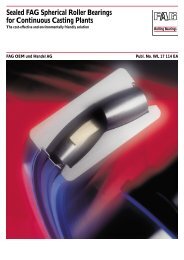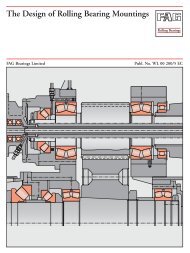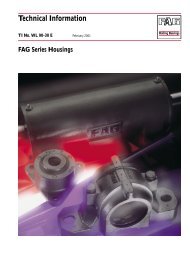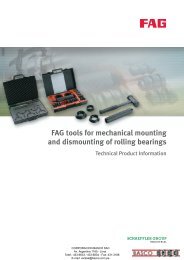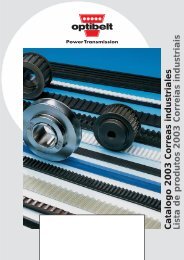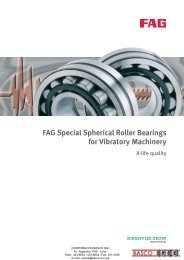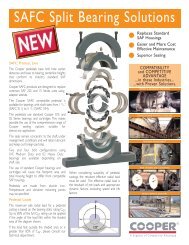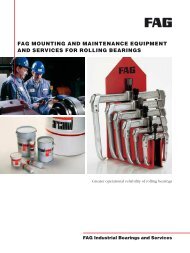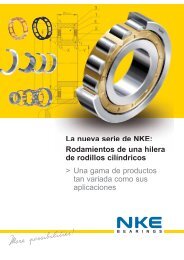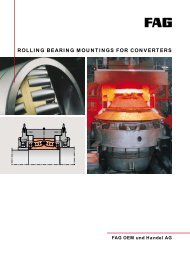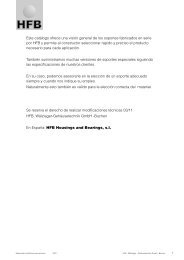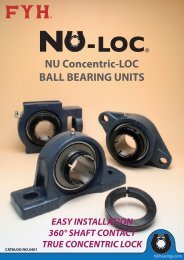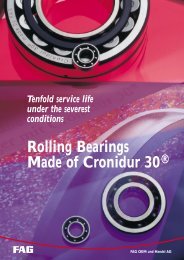75mm to 180mm SPLIT TAPERED BEARINGS
75mm to 180mm SPLIT TAPERED BEARINGS
75mm to 180mm SPLIT TAPERED BEARINGS
- No tags were found...
Create successful ePaper yourself
Turn your PDF publications into a flip-book with our unique Google optimized e-Paper software.
Grease quantity for initial lubricationThe quantity of grease required on initial lubrication isdependent upon operating speed and temperature.If the operating temperature is below 80°C the quantity ofgrease may be determined directly according <strong>to</strong> the bearingreference and operating speed from the table below. If theoperating temperature is above 80°C a 25% pack of greaseshould be used regardless of operating speed (refer <strong>to</strong> theright hand column of the table).With a ‘full pack’ of grease the space within the housing (i.e.surrounding the bearing components) in the assembled unit iscompletely filled with grease.The table assumes normal density grease (about 0.85 g/cm 3 ).Initial lubricant quantitiesRoutine GreasingRelubricate the bearing weekly or every 150 hours ofoperation.Sizes up <strong>to</strong> and including 120mm: Use 2ml of fresh grease.Sizes over 120mm: Use 4ml of fresh grease.Note that 2ml is approximately 1 shot from a conventionalside-lever grease gun.Au<strong>to</strong>matic lubrication systems should be metered <strong>to</strong> delivergrease at an average rate equivalent <strong>to</strong> the routine greasingperiods and quantities specified.If it can be done safely, the bearing should be re-greased as itrotates <strong>to</strong> help distribute the grease.Do not mix different types of grease in the bearing. Excessivequantities of lubricant should not be used, particularly athigh speeds, as this may result in excessive churning andoverheating.ShaftDiameterd (mm)BearingReferenceSpeed(rpm)up <strong>to</strong>Grease(full pack)(Kg)Speed (rpm)Grease(75% fullpack) (Kg)Speed (rpm)Grease(50% fullpack) (Kg)Speed (rpm)from <strong>to</strong> from <strong>to</strong> from <strong>to</strong>Grease(33% fullpack) (Kg)Speed(rpm)overGrease(25% fullpack) (Kg)75 1DTB75M 667 0.19 667 1333 0.14 1333 2000 0.10 2000 2667 0.06 2667 0.0580 1DTB80M 625 0.23 625 1250 0.17 1250 1875 0.12 1875 2500 0.08 2500 0.061390 1DTB90M 556 0.25 556 1111 0.19 1111 1667 0.12 1667 2222 0.08 2222 0.06100 1DTB100M 500 0.41 500 1000 0.31 1000 1500 0.20 1500 2000 0.13 2000 0.10110 1DTB110M 455 0.44 455 909 0.33 909 1364 0.22 1364 1818 0.14 1818 0.11120 1DTB120M 417 0.50 417 833 0.38 833 1250 0.25 1250 1667 0.17 1667 0.13140 1DTB140M 357 0.65 357 714 0.48 714 1071 0.32 1071 1429 0.21 1429 0.16160 1DTB160M 313 0.63 313 625 0.47 625 938 0.32 938 1250 0.21 1250 0.16180 1DTB180M 278 0.77 278 556 0.58 556 833 0.39 833 1111 0.25 1111 0.19Frequency DataBearing frequency data are included in this document for twopurposes:• <strong>to</strong> allow machine designers <strong>to</strong> check excitation frequenciesagainst resonant frequencies in the machine,• <strong>to</strong> allow correct input in<strong>to</strong> condition moni<strong>to</strong>ringequipment that uses these data.A roller bearing will excite vibrations at certain frequenciesrelated <strong>to</strong> the number, size and pitch circle diameter of therollers. To some extent this excitation is present even withnew bearings in perfect condition, as the load is carried ondiscrete, elastic, rolling elements which are constantly changingin angular position.The table at the <strong>to</strong>p of the page opposite indicates thefrequencies of bearing parts per shaft revolution, which can beused <strong>to</strong> calculate excitation frequencies directly by multiplyingthe tabulated frequencies by the shaft speed.The frequencies listed are explained as follows:‘Cage’ – the frequency at which a point on the cage enters andleaves the loaded zone of the bearing‘Roller’ – the frequency at which a point on a given rollerpasses in<strong>to</strong> contact with either the inner or outer race‘Outer’ – the frequency at which a point on the outer racecomes in<strong>to</strong> contact with successive rollers‘Inner’ – the frequency at which a point on the inner racecomes in<strong>to</strong> contact with successive rollersThe table also lists the pitch circle diameters, number of rollersand contact angle for use with condition moni<strong>to</strong>ring equipmentthat accepts this information.



